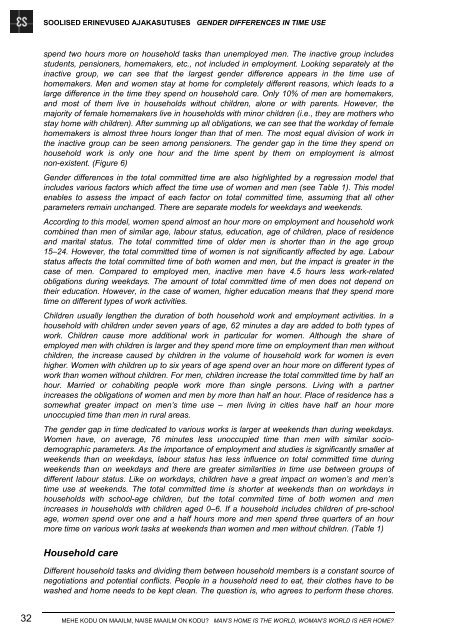MEHE KODU ON MAAILM, NAISE MAAILM ON KODU? - Tartu Ãlikool
MEHE KODU ON MAAILM, NAISE MAAILM ON KODU? - Tartu Ãlikool
MEHE KODU ON MAAILM, NAISE MAAILM ON KODU? - Tartu Ãlikool
Create successful ePaper yourself
Turn your PDF publications into a flip-book with our unique Google optimized e-Paper software.
SOOLISED ERINEVUSED AJAKASUTUSES GENDER DIFFERENCES IN TIME USE<br />
spend two hours more on household tasks than unemployed men. The inactive group includes<br />
students, pensioners, homemakers, etc., not included in employment. Looking separately at the<br />
inactive group, we can see that the largest gender difference appears in the time use of<br />
homemakers. Men and women stay at home for completely different reasons, which leads to a<br />
large difference in the time they spend on household care. Only 10% of men are homemakers,<br />
and most of them live in households without children, alone or with parents. However, the<br />
majority of female homemakers live in households with minor children (i.e., they are mothers who<br />
stay home with children). After summing up all obligations, we can see that the workday of female<br />
homemakers is almost three hours longer than that of men. The most equal division of work in<br />
the inactive group can be seen among pensioners. The gender gap in the time they spend on<br />
household work is only one hour and the time spent by them on employment is almost<br />
non-existent. (Figure 6)<br />
Gender differences in the total committed time are also highlighted by a regression model that<br />
includes various factors which affect the time use of women and men (see Table 1). This model<br />
enables to assess the impact of each factor on total committed time, assuming that all other<br />
parameters remain unchanged. There are separate models for weekdays and weekends.<br />
According to this model, women spend almost an hour more on employment and household work<br />
combined than men of similar age, labour status, education, age of children, place of residence<br />
and marital status. The total committed time of older men is shorter than in the age group<br />
15–24. However, the total committed time of women is not significantly affected by age. Labour<br />
status affects the total committed time of both women and men, but the impact is greater in the<br />
case of men. Compared to employed men, inactive men have 4.5 hours less work-related<br />
obligations during weekdays. The amount of total committed time of men does not depend on<br />
their education. However, in the case of women, higher education means that they spend more<br />
time on different types of work activities.<br />
Children usually lengthen the duration of both household work and employment activities. In a<br />
household with children under seven years of age, 62 minutes a day are added to both types of<br />
work. Children cause more additional work in particular for women. Although the share of<br />
employed men with children is larger and they spend more time on employment than men without<br />
children, the increase caused by children in the volume of household work for women is even<br />
higher. Women with children up to six years of age spend over an hour more on different types of<br />
work than women without children. For men, children increase the total committed time by half an<br />
hour. Married or cohabiting people work more than single persons. Living with a partner<br />
increases the obligations of women and men by more than half an hour. Place of residence has a<br />
somewhat greater impact on men’s time use – men living in cities have half an hour more<br />
unoccupied time than men in rural areas.<br />
The gender gap in time dedicated to various works is larger at weekends than during weekdays.<br />
Women have, on average, 76 minutes less unoccupied time than men with similar sociodemographic<br />
parameters. As the importance of employment and studies is significantly smaller at<br />
weekends than on weekdays, labour status has less influence on total committed time during<br />
weekends than on weekdays and there are greater similarities in time use between groups of<br />
different labour status. Like on workdays, children have a great impact on women’s and men’s<br />
time use at weekends. The total committed time is shorter at weekends than on workdays in<br />
households with school-age children, but the total commited time of both women and men<br />
increases in households with children aged 0–6. If a household includes children of pre-school<br />
age, women spend over one and a half hours more and men spend three quarters of an hour<br />
more time on various work tasks at weekends than women and men without children. (Table 1)<br />
Household care<br />
Different household tasks and dividing them between household members is a constant source of<br />
negotiations and potential conflicts. People in a household need to eat, their clothes have to be<br />
washed and home needs to be kept clean. The question is, who agrees to perform these chores.<br />
32<br />
<strong>MEHE</strong> <strong>KODU</strong> <strong>ON</strong> <strong>MAAILM</strong>, <strong>NAISE</strong> <strong>MAAILM</strong> <strong>ON</strong> <strong>KODU</strong>? MAN’S HOME IS THE WORLD, WOMAN’S WORLD IS HER HOME?

















